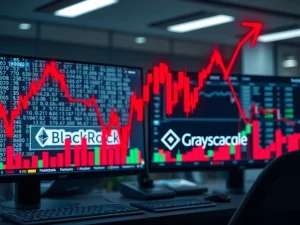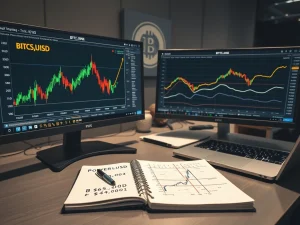Bitcoin Price: Unpacking the Critical $116K-$120K Range Amid Looming Macroeconomic Tensions

The cryptocurrency world is holding its breath as Bitcoin (BTC) finds itself in a precarious position, seemingly trapped within a tight trading range. For investors and enthusiasts keenly observing the Bitcoin price, the past week has been a testament to the delicate balance between bullish ambition and bearish pressure. As the digital asset oscillates between the $116,000 and $120,000 marks, the prevailing sentiment is one of anticipation, with everyone waiting for a significant catalyst to ignite the next major move. This stagnation isn’t just a minor blip; it reflects a broader market grappling with uncertainty, largely influenced by pivotal macroeconomic events on the horizon.
Understanding Bitcoin’s Current Price Action and Market Volatility
In recent days, the Bitcoin price has been a rollercoaster of modest gains followed by swift corrections. After a brief surge past $120,000, which saw BTC touch a remarkable record high of $123,091 last week, the cryptocurrency experienced a rapid pullback, dipping to an intraday low of $115,701. While it has since recovered to hover around $117,000-$119,000, this recent volatility underscores the fragile state of the market. Traders have observed a notable 1.7% decline on a single day and a 0.48% drop over the weekend, highlighting the persistent tug-of-war between buyers and sellers.
This range-bound behavior is not uncommon in the crypto market, but the current context makes it particularly compelling. Analysts are pointing to several factors contributing to this dynamic:
- Liquidity Clusters: Data from CoinGlass indicates significant liquidity clusters above the current price. This means there’s a substantial amount of buy and sell orders grouped at certain price points, which can amplify short-term volatility as the price approaches these levels. When price hits these clusters, it often triggers a cascade of trades, leading to sharp movements.
- Tug-of-War: The consistent back-and-forth between $116,000 and $120,000 signifies that neither bulls nor bears have managed to establish decisive control. Buyers are stepping in at lower bounds, while sellers are active at the upper limits, creating a bottleneck for price movement.
- Absence of a Clear Catalyst: Despite the inherent volatility of cryptocurrencies, a lack of a clear, strong fundamental or technical catalyst has prevented BTC from breaking out of this range. The market is effectively in a holding pattern, awaiting external cues.
The Looming Threat of Macroeconomic Events
The broader economic landscape is undeniably the most significant factor influencing Bitcoin’s immediate outlook. The final days of July are shaping up to be a critical period, packed with high-impact macroeconomic events that could dictate market sentiment for the rest of the year. Edul Patel, co-founder and CEO of Mudrex, aptly highlighted the confluence of these events, cautioning investors to brace for potential shifts.
Let’s break down these pivotal events and their potential impact on the crypto market:
- FOMC Meeting: The Federal Open Market Committee (FOMC) meeting is always a closely watched event. Decisions regarding interest rates, quantitative easing, and the Federal Reserve’s economic outlook can profoundly affect traditional financial markets. A hawkish stance (e.g., hinting at rate hikes or tapering) could lead to a flight from riskier assets like Bitcoin, while a dovish stance (e.g., maintaining low rates, continued stimulus) might provide a tailwind.
- U.S. Treasury Borrowing Plans (QRA Meeting): The Quarterly Refunding Announcement (QRA) details the U.S. Treasury’s borrowing needs and plans for the upcoming quarter. Large-scale bond issuance can drain liquidity from the market, potentially impacting asset prices across the board, including cryptocurrencies. Conversely, lower-than-expected borrowing could free up capital. Felix Juavin, host of Forward Guidance, specifically noted the QRA meeting as crucial for shaping policy clarity.
- President Trump’s Tariff Proposals: Geopolitical tensions and trade policies, such as new tariff proposals, can introduce significant uncertainty into global markets. Tariffs can disrupt supply chains, increase inflation, and slow economic growth, all of which can lead investors to seek safer havens or reduce exposure to volatile assets like Bitcoin. The Supreme Court’s deliberation on the legality of executive orders for tariffs adds another layer of complexity and uncertainty.
These events, individually and collectively, have the power to create ripple effects that extend far beyond traditional finance, directly influencing investor confidence and capital flows into the digital asset space. As Juavin remarked, "The last few days of July will set the stage for markets for the rest of the year," emphasizing that decisive moves will likely emerge only after these critical moments unfold.
Decoding Bitcoin Dominance and the Short Squeeze Potential
Amidst this range-bound action, another metric has caught the attention of market observers: Bitcoin’s dominance. This metric, which represents Bitcoin’s market capitalization as a percentage of the total cryptocurrency market capitalization, recently climbed to 62%. This upward trend signals a potential shift in market dynamics. Historically, an increasing Bitcoin dominance can suggest that capital is flowing out of altcoins and into Bitcoin, or that Bitcoin is holding its value better than altcoins during periods of uncertainty.
Some analysts interpret this rising dominance, combined with the accumulation of overhead liquidity, as a precursor to a "massive short squeeze." A short squeeze occurs when a cryptocurrency’s price suddenly surges, forcing traders who bet against it (short sellers) to buy back the asset to cover their positions, thereby pushing the price even higher. One trader emphatically stated, "Bitcoin liquidity is piling up on the topside. A massive short squeeze is inevitable!" This highlights the inherent risk for those entering late into short positions in a market prone to abrupt directional shifts. If Bitcoin breaks decisively above the $120,000 resistance, a significant short squeeze could indeed fuel a rapid ascent.
What Does This Mean for Your BTC Price Prediction?
For those attempting a BTC price prediction, the current scenario presents both challenges and opportunities. The immediate outlook remains range-bound, meaning Bitcoin is likely to continue trading between $116,000 and $120,000 until a major catalyst emerges. However, historical patterns suggest that Bitcoin has shown remarkable resilience in the face of macroeconomic uncertainty. Its decentralized nature and finite supply often make it an attractive hedge against inflation or traditional market instability, though this correlation isn’t always immediate or direct.
Key levels to watch, as highlighted by traders, are the $115,000 support and the $120,000 resistance. A decisive breakthrough above $120,000 could signal the start of a new bullish leg, potentially targeting higher highs before the year-end. Conversely, a sustained break below $115,000 could open the door for further downside, testing psychological support levels lower down. Investors should be prepared for increased market volatility around these critical thresholds.
Beyond the immediate price action, it’s crucial to note ongoing institutional activity. Despite the current stagnation, major firms are continuing to expand their BTC holdings. Genius Group, for instance, is actively increasing its Bitcoin exposure, signaling long-term confidence in the asset. Similarly, London-based Satsuma Technology recently set a national record for Bitcoin treasury raises, demonstrating continued institutional appetite for integrating Bitcoin into corporate balance sheets. This institutional backing, while not always leading to immediate price surges, provides a foundational layer of support and validates Bitcoin’s growing acceptance as a legitimate asset class.
Navigating the Crypto Market: Actionable Insights for Investors
Given the current climate of uncertainty and range-bound trading, what should investors do? Here are some actionable insights:
- Monitor Macroeconomic Events Closely: Pay close attention to the outcomes of the FOMC meeting, U.S. Treasury announcements, and any developments regarding tariffs. These events will be the primary drivers of market sentiment in the short to medium term.
- Observe Liquidity Dynamics: Keep an eye on data related to liquidity clusters and order books. Understanding where significant buy and sell walls are positioned can provide clues about potential price movements and areas of strong support or resistance.
- Define Your Risk Tolerance: Volatility is inherent in the crypto market. Ensure your portfolio aligns with your risk tolerance. For some, this might mean reducing exposure to highly volatile assets, while for others, it could be an opportunity for strategic entry or exit.
- Practice Patience: In a range-bound market, impulsive decisions can be costly. Patience is key. Wait for clear breakouts or breakdowns from the established range before making significant trading moves.
- Consider Dollar-Cost Averaging (DCA): For long-term investors, continuing a DCA strategy can be effective. This involves investing a fixed amount at regular intervals, regardless of price, which helps average out the purchase price over time and reduces the impact of short-term volatility.
- Stay Informed on Institutional Activity: While not a direct price driver, continued institutional adoption (like Genius Group and Satsuma Technology’s moves) reinforces the long-term bullish case for Bitcoin.
Conclusion: Awaiting the Catalyst in the Crypto Market
The current state of the crypto market, with Bitcoin firmly entrenched in its $116,000-$120,000 range, is a period of intense observation and strategic positioning. While the immediate lack of a clear catalyst creates stagnation, the underlying tensions from crucial macroeconomic events are building, promising a decisive shift in the near future. The tug-of-war between buyers and sellers, amplified by liquidity dynamics and the potential for a short squeeze, paints a complex picture. Whether Bitcoin breaks out upwards fueled by institutional interest and a favorable macroeconomic turn, or succumbs to downside pressure from unfavorable economic news, the coming weeks will undoubtedly set the stage for the rest of the year. Investors are advised to remain vigilant, informed, and prepared for increased market volatility as these pivotal events unfold, shaping the next chapter for the world’s leading cryptocurrency.
Frequently Asked Questions (FAQs)
Q1: Why is Bitcoin stuck in a $116K-$120K range?
A1: Bitcoin is currently experiencing a tug-of-war between buyers and sellers, leading to a tight trading range. This is primarily due to a lack of a clear catalyst for a breakout and heightened market anticipation of significant macroeconomic events, which are causing investors to hold positions rather than push for a definitive direction.
Q2: How do macroeconomic events impact Bitcoin’s price?
A2: Major macroeconomic events like FOMC meetings (interest rate decisions), U.S. Treasury borrowing plans, and tariff proposals can significantly influence global market sentiment. Positive economic news or dovish central bank stances can encourage investment in risk assets like Bitcoin, while negative news or hawkish policies can lead to capital outflow and price declines, as investors seek safer havens.
Q3: What is a "short squeeze" in the context of Bitcoin?
A3: A short squeeze occurs when the price of an asset, like Bitcoin, rapidly increases, forcing traders who had bet on its price falling (short sellers) to buy back the asset to limit their losses. This sudden buying pressure further drives the price up, creating a cascading effect. Analysts suggest that significant liquidity piled up above Bitcoin’s current price could trigger such a squeeze.
Q4: What does Bitcoin’s 62% dominance mean for the crypto market?
A4: Bitcoin dominance measures BTC’s market capitalization relative to the entire crypto market. A rise to 62% suggests that Bitcoin is either holding its value better than altcoins or that capital is flowing from altcoins back into Bitcoin, often seen during periods of market uncertainty as investors prefer the perceived safety of the largest cryptocurrency.
Q5: What should investors do during this period of market volatility and uncertainty?
A5: Investors are advised to monitor key macroeconomic events, observe liquidity dynamics, and define their risk tolerance. Practicing patience, considering dollar-cost averaging for long-term goals, and staying informed about institutional activity can also be beneficial strategies during this range-bound and uncertain period.










